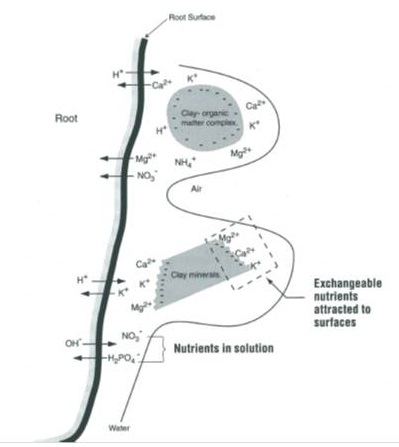Cation exchange capacity
Learn about cation exchange capacity (CEC) which describes a soil’s ability to hold and exchange cations and is a relative reflection of a soil’s potential fertility.
The cation exchange capacity (CEC) describes a soil's ability to hold and exchange cations. It is a relative reflection of a soil's potential fertility. High CEC soils are able to retain more cations and have a greater capacity to exchange them than low CEC soils.
Cations most commonly reported ones on a soil report are: potassium (K+), magnesium (Mg2+), and calcium (Ca2+). Some reports will also give hydrogen (H+) and sodium (Na+). Cations are positively charged nutrient ions.
Cations are held on negatively charged sites found on organic matter and clay surfaces (Figure 1). Organic matter has more exchange sites than clay particles. These sites are the major source of all available cations for plant uptake. Cations are not held tightly to these surfaces. Rather they are continually resupplying the soil solution as cations are removed by plant uptake.
Increasing a soil's CEC
Organic matter provides more exchange sites than clay. Maintain and increase organic matter by adding it, crop rotation or cover crops to raise soil CEC. Avoid soil management practices such as excessive tillage that destroy organic matter. A soil's clay content contributes to CEC as well but changing it is not a feasible management option.
Soil Report CEC
A CEC reported on a soil test is estimated using the reported K, Mg and Ca values. The reported values are converted to milli-equivalents per 100 g of soil (meq/100 g) and added together to estimate the CEC. The numbers will be the same if reported as centimoles of positive change per kilogram (cmol+/kg).
CEC and soil management implications
CEC range 1–10
- High sand content.
- Nitrogen and potassium more likely to leach.
- Less lime needed to adjust soil pH.
- Low organic matter.
- Low water holding capacity.
CEC range 11–50
- High clay content.
- More lime required to adjust soil pH.
- Higher capacity to hold nutrients at given soil depth.
- Higher organic matter.
- Higher water holding capacity.
Source: Soil Fertility Manual, IPNI, 2006.
